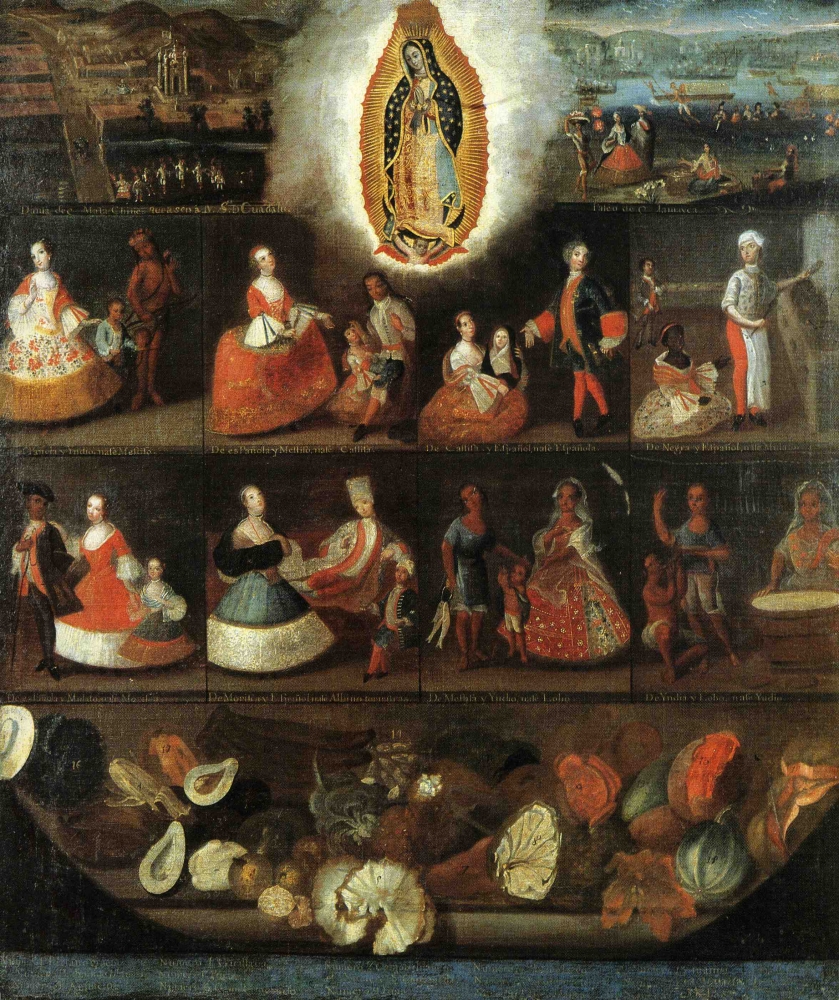
Holy Anomaly

In 18th-century Mexico, casta paintings were all the rage, as the bloodlines of Spanish colonizers and of the colonized indigenous, black and mixed-race populations mingled and American-born Spaniards sought to define themselves apart amid increasingly blurry racial lines. Paintings of racial hierarchy, or casta paintings, put fictive family groupings, with father of one race, mother of another and children a third racial category, in hierarchical order. White Europeans (españoles) were at the top, with mixtures with indigenous (indios) and Africans (negros) in descending order.
The compositions were painted not only to show and label the emerging hybrid populations, but also to classify them according to contemporary social hierarchies. The paintings asserted American-born Spaniards’ racial superiority in Mexico’s increasingly mixed-race society, but likely also embodied their anxiety about their status as “racially pure.”
“Nobody knows exactly why they were painted,” said Sarah Cline, a professor of history at UC Santa Barbara, “nor why they were painted almost exclusively in Mexico, rather than in other parts of the Spanish Empire.” Some thought they might be to aid priests to place individuals in baptismal registers, which were classified by race. Cline’s article on one particular painting, “Guadalupe and the Castas: The Power of a Singular Colonial Mexican Painting,” was published in the binational, University of California Press scholarly journal Mexican Studies/Estudios Mexicanos. The journal’s editorial offices are located at UCSB with Ruth Hellier-Tinoco, an associate professor of music, serving as editor-in-chief.
Cline chose to analyze one casta painting that stands out from the hundreds produced: Luis de Mena’s “Castas,” because it was the most frequently seen and because it was most unusual in the genre. Mena’s painting is a large (43 x 41 in) oil on canvas painted around 1750, now displayed in Madrid’s Museo de América. While the work has the requisite parade of families and designations that were both popular and illustrative of race-related anxieties of the time, it also has the distinction of being the only casta painting to feature Mexico’s Virgin of Guadalupe, effectively turning what was a secular art form into something with a quasi-religious message.
“The Virgin of Guadalupe’s image was very strictly regulated in the colonial period,” said Cline. While depictions of mixed-race castas and portrayals of the Dark Virgin of Mexico each were popular in their own realms, according to Cline, Mena’s painting has become iconic within the casta genre without most viewers knowing that it is not at all typical.
For her in-depth analysis of this often seen, yet little-studied painting, Cline has received the Latin American Studies Association’s (LASA) Humanities Essay prize. Awarded under the international organization’s Mexico section, the prize recognizes a “single- or multi-authored essay published in a peer-reviewed journal, edited book or collection of conference papers that reflects outstanding originality in its treatment of any aspect of Mexico.”
“As editor of the UC Press journal Mexican Studies/Estudios Mexicanos, I am thrilled that Dr. Sarah Cline’s article,‘Guadalupe and the Castas: The Power of a Singular Colonial Mexican Painting,’ won the 2016 LASA (Latin American Studies Association) Mexico Humanities Essay Prize,” said Hellier-Tinoco. “Sarah’s article was published in the second issue of MS/EM under my editorship, therefore it is gratifying to know that the level of scholarship is judged to be of the highest quality.
“I was excited to nominate Sarah’s article for the LASA Mexico prize, for her fascinating work is an enlightening journey through visual and linguistic representations, solidly grounded in the discipline of colonial Mexican history (Sarah’s long-standing area of deep expertise), and a superb analysis of an iconic painting from the mid-eighteenth century. The painting, which includes the iconic Virgin of Guadalupe, is concerned with representing legal classifications of racial hierarchies (with implicit class and gendered aspects), subjects that are wholly pertinent to complex contexts in and between Mexico, the USA, Europe and other world settings today. One of my aims for the journal was to curate articles with relevance and insights for contemporary contexts, and Sarah’s article achieves this in an outstanding way.
“Having been aware of Sarah’s fascination with the casta (mixed-race) paintings almost since our first meeting, although my research is based in complementary disciplinary fields of performance studies, dance, theater, music, and cultural history of Mexico, I have long been intrigued by these visual and linguistic formulations of societal structures in New Spain, and indeed, make reference to them in my own teaching at UCSB. Therefore, when Sarah submitted her article to MS/EM for consideration, and after approval through thorough international peer review processes, it was a great pleasure to work with her to bring her article to publication.
“Congratulations to Sarah for her excellence in scholarship and her contribution to Mexican Studies.”
Cline’s scrutiny of the painting reveals other uncommon elements as well. Women, typically the less dominant figures in these types of paintings, are more prominent than usual. In addition, Mena’s painting eschews the more common 16 panels showing potential racial combinations in favor of just eight, while adding day-in-the-life scenes at the top and a still life of mostly New World fruits, complete with labels, at the bottom. Taken together, all the elements — the Virgin, the landscape and scenes of daily life, the casta families and the fruits — point to several possible interpretations for this particular painting.
“In some sense the painting is all of late colonial Mexico in a box — from the elite point of view,” said Cline. “It shows the uniqueness, richness and complexity of Spain’s most valuable colony.” Cline, who also won the 2016 Edwin Lieuwen Award for the Promotion of Excellence in the Teaching of Latin American Studies from the Rocky Mountain Council for Latin American Studies, often used this painting in her classes, encouraging students to look carefully at all the elements and consider how they fit together. “It sparked terrific discussions about race and hierarchy and the role of the Virgin of Guadalupe,” she said.
The presence of the Virgin de Guadalupe is the key anomaly of this casta painting. Cline drew on extensive scholarship on the Guadalupe, which emphasizes how she was regulated down to the number of rays emanating from her body and the number of stars on her cloak. For Cline, the message from Mena’s central placement of the Virgin in his casta painting might well be, “Even though there’s a racial hierarchy here, I am the Virgin Mother of all Mexicans. And all of Mexico is under my sacred gaze.”
The artist’s juxtaposition of several exotic elements on a single canvas was meant more to intrigue an Old World audience — particularly Spaniards from the Iberian peninsula — who had never seen Spain’s overseas territories. Think of it as a Mexican travel poster of sorts. “That has also been a supposition,” said Cline.
Of the hundreds of casta paintings produced in the 18th century, Mena’s painting with Guadalupe at its center is the most-reproduced. “Even though it is a unique and anomalous painting, you have all of late colonial Mexico on one canvas,” she said. Despite studying it for years, “it still intrigues and delights me.”



